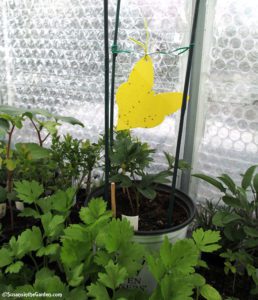Whiteflies
Latin name: There are over 1,200 species of whiteflies but one of the most bothersome is the greenhouse whitefly, Trialeurodes vaporariorum.
Size: 1/16″
Color: White
Life cycle: Adult females lay from 200-400 eggs on the undersides of leaves. The larvae hatch in a week and go through some instar stages prior to pupating. They emerge from a slit, mate and lay eggs. Adults live for about a month. There are many generations throughout a season.
Symptoms of their activity: If you brush against a plant and a cloud of tiny white insects take to the air, those are whiteflies! They are not actually flies at all, but are sap-suckers like aphids. As a matter of fact, whiteflies produce honeydew just like aphids.
Typically seen on: Greenhouse plants, grape leaves, rhododendron leaves, tomato plants, some cabbage family crops, and more.
Controls: Sticky traps (see photo).
Cultural controls: Monitor susceptible plants frequently and any new plants you bring home from a nursery. Remove any leaves with early signs of the insects while they’re in the early life stages (before they can fly and reproduce).
Natural predators: Spiders, big-eyed bugs, damsel bugs, ladybugs, lacewings, minute pirate bugs, parasitic wasps. Avoid using chemicals to control the whiteflies so they won’t adversely affect these predators!
Additional information: Missouri Botanical Garden Whiteflies, Oregon State University Whiteflies, and Iowa State Whiteflies.
Back to Organic Pest Control

